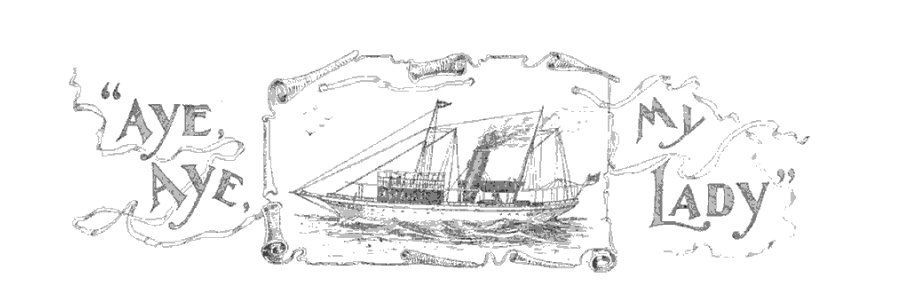 Aye, Aye, My Lady
Aye, Aye, My Lady
Yachtsmen of the old school are always conservative. Some of them are cranks. The New York Yacht Club has a few of these eccentric antiques on its muster roll, who serve as a foil to the lively and progressive members with which the organization abounds.
When Mrs. Lucy C. Carnegie, of Pittsburg[sic], Pa., ordered her new steam yacht Dungeness, she thought it would be a capital thing if she could prevail upon the New York Yacht Club to grant her permission to fly the club burgee and to use the club floats and stations. With this ended in view she opened diplomatic negotiations, and caused as much consternation among the “old barnacles” just alluded to as a hungry hawk in a chicken walk.
Mrs. Carnegie’s sponsors were Mr. Archibald Rogers and Mr. Fairman Rogers, two fo the most popular men in the domain of clubdom, and each an excellent and enthusiastic sportman. When these gentlemen proposed her for membership, the old fogies were aghast. In dark corners of the club, over strong cigars and jorums of punch, they brooded over their troubles and caucused and caballed with all the dark secrecy and tireless energy of South American conspirators plotting a revolution.
The worst of it was they were so few in number, and their cause was so patently weak and flaccid, that they reminded one of the Irishman who flocked by himself. When they sought sympathetic followers they found “offensive partisans,” all devoted to Mrs. Carnegie; and thus the conspirators were foiled and Lovely Woman won the day.
At the last general meeting of the club, held on May 17, the constitution was amended, and now any woman owning a yacht is eligible as a flag member. She may fly the club burgee, have her private signal emblazoned in the club book, enter her yacht in races, and use the club floats and stations to her heart’s content.
There is, however, one proud prerogative from which she is debarred, and that is the right of suffrage. The male owner of a 40-footer, that leaks like a sieve, can vote, but the club is not yet prepared to allow a like privilege to the possessor of a steel steam yacht, brand new, 135 feet long, and superbly appointed. But the pessimists say the entering wedge has been driven in, and they predict, with dismay, the reign of a petticoated commodore–the very thought of which dread contingency makes them feel like taking a swim in the styx.
The more gallant and go-ahead members take an opposite view and would welcome with open arms (this is, of course, figurative) as many ladies as possible into the club. The more the merrier is their jocund cry. What would the cruise of the New York Yacht Club–the great aquatic event of the year–be without the girls? Mighty dull I promise you, and as insipid as cold boiled veal without the stimulating and snappy addition of salt and red pepper.
That the club is quite eager for more ladies to join the body is significantly shown by the circumstance that it does not exact its usual pound of flesh from women yacht owners, but gallantly lets them off from paying the entrance fee and is content with the annual dues.
Mrs. Carnegie is a devoted yachtswoman. In her old steam yacht Missoe she has made many a delightful cruise, but in her new boat, Dungeness, designed by Mr. George B Mallory of this city and built at Sparrow’s Point, Md., she may venture on voyages of more ambitious endeavor and greater length. The trial trip of the Dungeness was eminently successful, and she may be expected in these waters ere long.
No money has been spared in the fitting out of this vessel, for she is owned by a lady of immense wealth, whose winter home on Cumberland Island, off the coast of Georgia, is one of the finest in the South. Cumberland Island is a lovely place, with beautiful parks and gardens, with preserves abounding in game, and, in fact, everything that gives zest to existence.
Mrs. Carnegie is a widow in the prime of life, and the fact that she has a lovely daughter approaching a marriageable age may not be without interest to certain young bachelor yacht owners who voted for her mother’s admission to the yacht club.
That other clubs will follow the example so nobly set by the premier yachting organization of America is as certain as the rising of the sun to-morrow morning. The Seawanhaka Corinthians, although hitherto credited with dry devotion to nautical science and souls whose only solace, according to popular belief, is in logarithmic sines, tangents, and secants, surprised the yachting world by their action at their last general meeting, by electing Mrs. C.B. Thompson an honorary member for the year.
Mrs. Thompson is in her element on the sea. She prefers sailing craft to steam yachts, and can take her trick at the tiller with the best. She owns the smart little cutter Indra, and in Newport last year was often seen sailing her with her boys, and handling her capitally, too. For more extended cruising she chartered the schooner Orithyia, in which she sailed on the Sound and also enjoyed several trips off shore. Finding this vessel scarcely large enough for her, she recently purchased the fine and fast schooner OEnone from Mr. Hugh Cochraine, a member of the New York and Eastern Yacht clubs whose home is in Boston.
The OEnone is a smart racing craft designed by the late Mr. Burgess. She is by no means outclasses yet, but can show the graceful contour of her fantail stern to many of the schooners enrolled int he New York Yacht Club. I have it on excellent authority that Mrs. Thompson will be the next lady empowered to fly the burgee of the club, and that she will enter her yacht in the regatta of the club and also make a bold bid for the handsome cups presented to the yachts making the fastest passages from port to port during the August squadron cruise.
Thus the era of lady membership begins under favorable auspices. That no girl will be considered positively “swagger” unless she is also a yacht owner is not unlikely in the near future. The ambition of the American girl is boundless, and nobody doubts her daring. That a lady may yet defend the America’s cup is by no means beyond the bounds of possibility, and I hope to live to see the fun.
In England, ladies have recently been admitted as members of that august body, the Yacht Racing Association of Great Britain, before whose sceptre all the recognized clubs bow down and before whose dread tribunal delinquents are summoned and duly disciplined. English women have taken great interest in the sport for many years, but it cannot be said to have yet attained the dimensions of a fashionable ad. But the pastime is becoming more popular every day, and who knows that an international rivalry of absorbing interest may not in time be developed, and that American girls may vie with their English cousins for honors on the open sea? If they do, I know not on what side my bets would be placed.
Isn’t that a fun piece? I like how progressive the author is, though I don’t think the “old barnacles” were overthrown quite as quickly as Kenealy might have predicted from 1894.
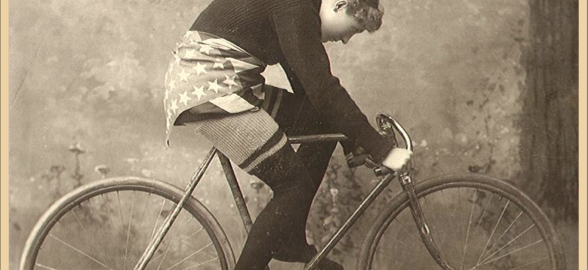
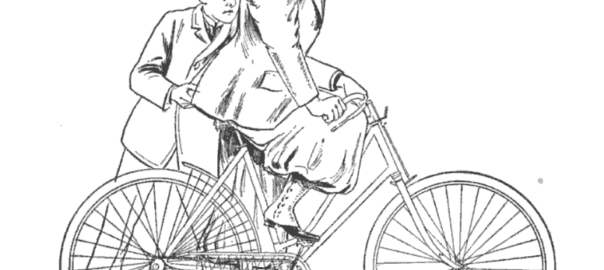
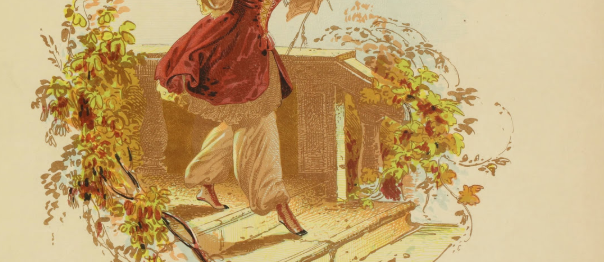

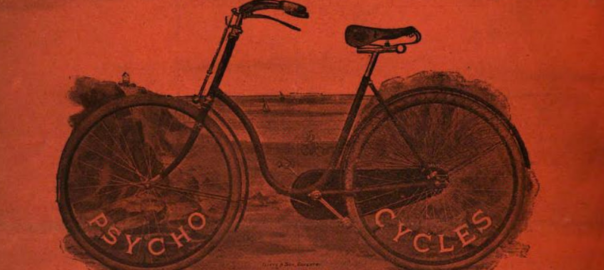
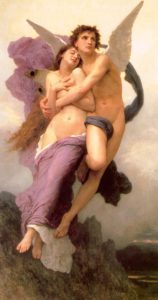
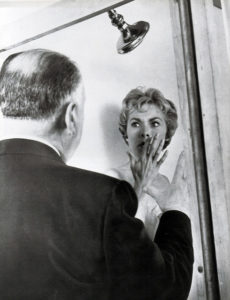
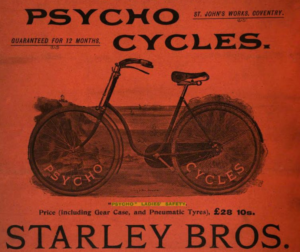
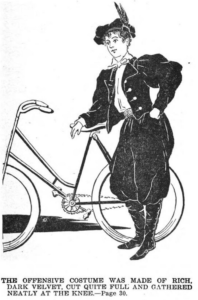
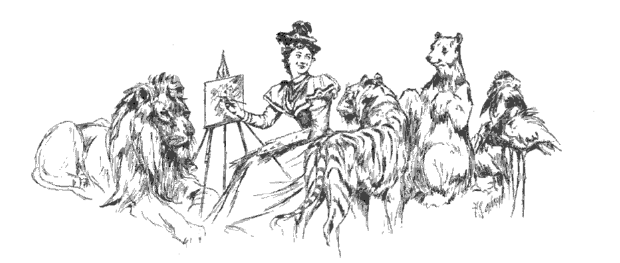
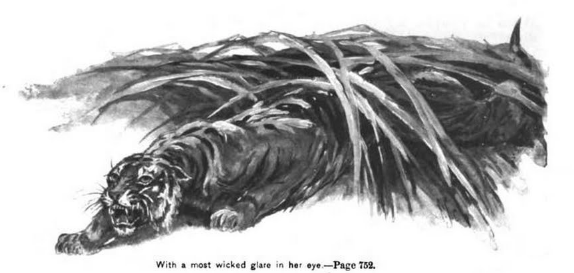 I took the order, but do you know I was never able to make that animal take the fatal leap. With a great of persuasion I induced Mr. Conklin, the former careful and thoroughly experienced superintendent at the Central Park Zoo, to allow a tiger to be enraged up to a most desperate point, by having a young bear cub placed dangerously near his cage, and I made lots of studies in movement and expression of that animal’s most ferocious efforts to get at that cub, but it was of no use. I then changed the whole idea, and made a recumbent tigress looking up with a most placid expression into the face of the young woman, who still continued to dream over the lilies. The “reincarnationist” was disgusted, and I sold my “idyl” at a quarter of the price to “another fellow.” That change of expression cost me $750, and should have taught me a lesson, which some of my realistic friends would say served me right.”
I took the order, but do you know I was never able to make that animal take the fatal leap. With a great of persuasion I induced Mr. Conklin, the former careful and thoroughly experienced superintendent at the Central Park Zoo, to allow a tiger to be enraged up to a most desperate point, by having a young bear cub placed dangerously near his cage, and I made lots of studies in movement and expression of that animal’s most ferocious efforts to get at that cub, but it was of no use. I then changed the whole idea, and made a recumbent tigress looking up with a most placid expression into the face of the young woman, who still continued to dream over the lilies. The “reincarnationist” was disgusted, and I sold my “idyl” at a quarter of the price to “another fellow.” That change of expression cost me $750, and should have taught me a lesson, which some of my realistic friends would say served me right.”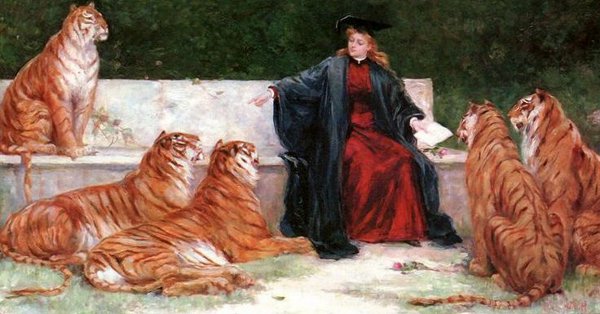
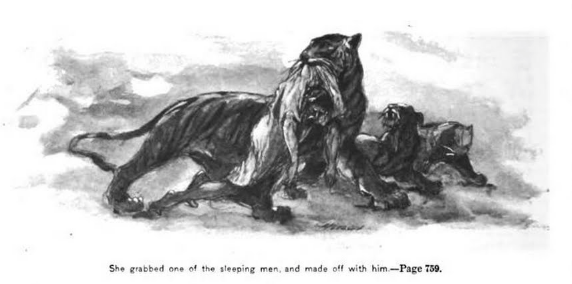 Just think the peculiar intelligence shown not only in her successful raid, but in her instructions to her cubs, who she made wait outside for her while she did her terrible work!
Just think the peculiar intelligence shown not only in her successful raid, but in her instructions to her cubs, who she made wait outside for her while she did her terrible work!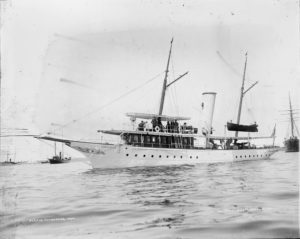 For my historical romance in progress, I have a scene set on a steam yacht. I went looking for info about such vessels and settled upon a particular historical boat to use as a model in the scene – the Dungeness, owned by Mrs. Lucy Carnegie, widow of Pittsburgh steel magnate Andrew Carnegie’s brother Thomas.
For my historical romance in progress, I have a scene set on a steam yacht. I went looking for info about such vessels and settled upon a particular historical boat to use as a model in the scene – the Dungeness, owned by Mrs. Lucy Carnegie, widow of Pittsburgh steel magnate Andrew Carnegie’s brother Thomas. Aye, Aye, My Lady
Aye, Aye, My Lady